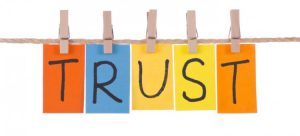Your best friend tells you that GMOs are in your food, and they are bad for the environment. You see an article posted by Dr. Oz saying that you should try this new life-changing diet. These are just some of the “tips” that consumers see and hear on a daily basis on what and what not to do when it comes to food choices. But how are consumers supposed to know what is reliable with all of the many sources and outlets in society today? This was the topic of a webinar with the Center for Food Integrity that seeks to gain consumer trust in the food system to provide the knowledge that is desperately needed. With the many nutrition “experts” in the media, bad science, and buzzwords everywhere, consumers are fearful of who they can actually trust.
Every year, the Center for Food Integrity conducts a survey to see what consumers’ thoughts and actions are when it comes to food choices. From their most recent survey, it was found that consumers make more of their food choices based on shared values from relationships with others rather than received facts. This emphasizes the influence of trust, and therefore the importance of the food systems shifting their approach to shared values to connect with the consumer. Consumers do not feel engaged to the food system and are seeking transparency and the need to be heard. Of course facts do not need to be abandoned all together, but the nutrition and health professionals should be leading the facts with shared values to be communicated effectively. The goal of communication should not be to persuade or educate, but rather to embrace the skepticism. Sarah Downs, a registered dietitian that led part of the webinar, provided a helpful tool for communicating with individuals: “listen, ask, share”. She believes in listening without judgment and listening to a person’s values first, then asking questions about thoughts and beliefs. Everyone has different values, whether it is difficulty finding affordable food, being fearful of food recalls, or wanting to eat organic foods, therefore listening is key to understanding. Sharing should include sharing your own perspective and values with an individual, so a connection can be bridged together. Whether it is family, integrity, or quality, everyone has values that impact their food choices and beliefs.
This information is especially useful for dietitians, clinicians, and other professionals in the nutrition field when having conversations with clients about food choices. Dietitians should also use their expertise through social media as well since that seems to be the main outlet consumers receive information. For more information on this topic, FoodIntegrity.org and BestFoodFacts.org are great resources for nutrition professionals or for the everyday consumer.

I agree with you regarding public health professionals disseminating their information via social media outlets, given the fact that social media outlets are a main source of misinformation about food. That being said, I think that merely disseminating the information out there does not mean that people will listen.
I think the “listen, help and share” tool is a good start in learning how to better communicate with the public, but I feel it needs to go deeper than that. I think that in order for the message to effective, professionals need sources and trainings of their own. For example, having a basic foundation in learning theories could greatly benefit practitioners in communicating information to the populations along with designing online content to target a general or specific population. The message is as good as the delivery(or content) in my opinion. I particularly like the BestFoodFacts.org site because it was user friendly and had a lot of good content!
This survey connects back to our discussion in class the other week on how much one’s social support network influences his or her food choices. Much of the information, or misinformation, people receive, particularly if it is coming through social media, is circulated through their social network. They may see a new diet fad article shared on Facebook or hear about a GMO-based food to avoid from a friend. Many friends or siblings will start diets together in order to have some accountability, and if both people have been misinformed, the information will only spread throughout the social network.
I definitely agree that more action needs to be taken than simply disseminating important nutritional information to dispel some of the “tips” consumers encounter. The “listen, help and share” tool is a great start and definitely a useful tool for practitioners to help their clients in the best way possible. Webinars, seminars, and informational classes for those interested in learning about healthy eating habits could be a great start as well.
As a dietetic intern this summer, I sat in on an outpatient counseling for people considering bariatric surgery–I remained silent during the counseling session (though I was dying to enter the dialogue). A woman in one particular session had fallen victim to Dr. Oz, the belief that all refined carbohydrates were the sole reason she was fat, and that dairy was causing all of her thyroid problems. As my eyes bounced back and forth between the RD and our very frustrated and defeated client, I saw the walls go up. This was an incredible opportunity the RD had to practice “Listen, Help, Share”, which is how I would have handled the situation, but instead, I observed judgement, invalidation of the patient’s feelings and close mindedness. Is the popular media wrong? From the practitioners eyes, most of the time. However, this RD wasted a perfect opportunity to empower her patient with knowledge and meet her where she was. Instead, she pushed the client away and made her feel uncomfortable. I completely agree with this article, and wish I could have watched the webinar. As a nutrition professional, half of my job is knowing the facts to debunk some of the popular media’s knowledge, but I will aim to *never* make my clients feel uncomfortable about their knowledge base.